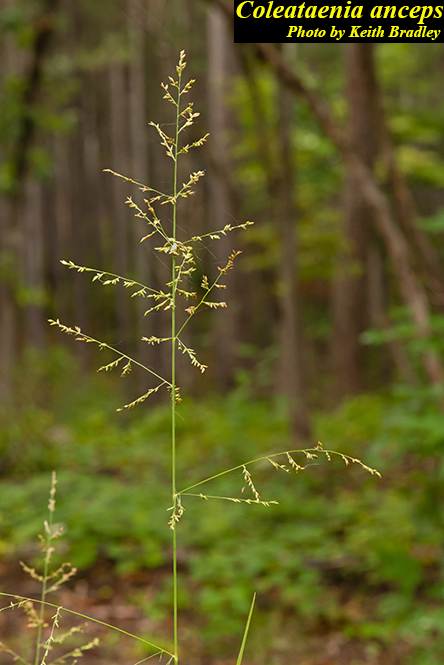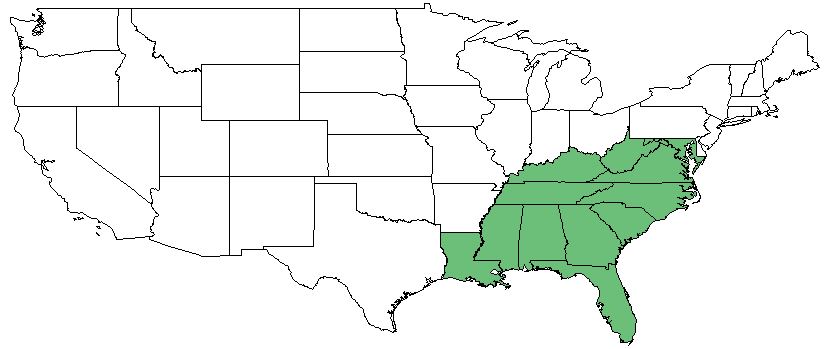Coleataenia anceps
Common Names: Beaked Panicgrass [1]
| Coleataenia anceps | |
|---|---|

| |
| Photo by the Atlas of Florida Plants Database | |
| Scientific classification | |
| Kingdom: | Plantae |
| Division: | Magnoliophyta - Flowering plants |
| Class: | Liliopsida - Moncots |
| Order: | Cyperales |
| Family: | Poaceae |
| Genus: | Coleataenia |
| Species: | C. anceps |
| Binomial name | |
| Coleataenia anceps Michx. | |

| |
| Natural range of Coleataenia anceps from Weakley [2] | |
Contents
Taxonomic Notes
Synonyms: Panicum anceps Michaux; Sorengia anceps (Michaux) Zuloaga & Morrone ssp. anceps; Panicum anceps Michaux var. anceps; Panicum anceps Michaux ssp. anceps; Sorengia anceps (Michaux) Zuloaga & Morrone ssp. rhizomata (A.S. Hitchcock & Chase) Zuloaga & Morrone; Panicum anceps Michaux var. rhizomatum (A.S. Hitchcock & Chase) Fernald; Panicum anceps Michaux ssp. rhizomatum (A.S. Hitchcock & Chase) Freckmann & Lelong; Panicum rhizomatum A.S. Hitchcock & Chase
Varieties: none
Subspecies: Coleataenia anceps (Michaux) Soreng ssp. anceps; Coleataenia anceps (Michaux) Soreng ssp. rhizomata (A.S. Hitchcock & Chase) Soreng
Description
C. anceps is a perennial graminoid of the Poaceae family native to North America.[1] Leaf blades elongated, glabrous or pubescent, and flat. Culms glabrous and erect. Ligules membranous and irregularly shaped. Inflorescences panicles that are open, which are ascending and containing appressed and short branchlets. Spikelets unevenly positioned on pedicle. First glume is angled sharply and comprises almost all of the base of the spikelet, and the second glume is the length of the spikelet and curved like a bird's beak. Palea and lemma that are fertile are angled, the color of straw, and comprising of stiff hairs to make it slightly pubescent. Caryopsis purple and oval-shaped.[3]
Differentiating between the subspecies, Coleataenia anceps ssp. rhizomata tends to have hairier leaves than C. anceps ssp. anceps. As well, to differentiate between C. anceps ssp. rhizomata and C. rigidula ssp. condensa, the sheaths of ssp. rhizomata vary from sparsely to densely villous, principally near the margin, while ssp. condensa are either completely glabrous or appressed pubescent distally.[2]
Distribution
This weedy graminoid can be found in the United States, from the east coast west to Illinois and Texas. [2]
Ecology
Habitat
C. anceps is tolerant of a variety of habitats such as dry sandy soil and standing water regions; however, swamp regions are its ideal habitat, with partial shade. It is listed as a facultative and facultative wetland species, occurring mainly in wetlands but also occasionally in non-wetlands.[1]
Specimens of C. anceps have been collected from habitats including upper tidal swamps, edge of rivers, in dune swale, ind rying sandy loam of open flatwoods, burned over cypress swamp, pine flatwoods, moist sands of roadsides, moist sands in hammock clearing, and longleaf pine flatwoods. [4]
Phenology
once a year the C. anceps flowers, in the fall, and produces its seeds that are germinated in the fall and early winter. [1]
Use by animals
C. anceps consists of approximately 10-25% of the diet for water birds and terrestrial birds.[5] This species is grazed by cattle and deer, and birds as well as waterfowl eat the seeds.[6]
Conservation and Management
For management, it should be noted that close grazing of this species causes the basal tufts to widely spread as well as the leaves to form a dense cover over the small areas it is found.[6] Grazing through the summer improves the plant's vigor and density, but overgrazing can allow other plants of lesser value to colonize.[3]
Cultivation and restoration
This grassy weed can be used for restoring regions used for mining, logging, timber roads, and other eroded sites by reintroducing this vegetation.[3]
Photo Gallery
References and notes
- ↑ 1.0 1.1 1.2 1.3 USDA Plant Database
- ↑ 2.0 2.1 2.2 Weakley, Alan S. 2015. Flora of the Southern and Mid-Atlantic States: Working Draft of 21 May 2015. University of North Carolina, Chapel Hill, North Carolina. 1320 pp.
- ↑ 3.0 3.1 3.2 Newman, S. D. and M. Gates. (2006). Plant Guide: Beaked Panicgrass Panicum anceps. N.R.C.S. United States Department of Agriculture. Baton Rouge, LA.
- ↑ URL: http://herbarium.bio.fsu.edu. Last accessed: June 2018. Collectors: M. Darst, R. Mattson, G. Mahon, J. Good, Loran Anderson, Ann F. Johnson, R.K. Godfrey, R. Fral, J.P. Gillespie, Richard S. Mitchell, William Reese, Paul Redfearn, R.E. Perdue. States and counties: Florida (Dixie, Wakulla, Bay, Leon, Franklin, Nassau, Madison, Taylor, Jackson, Jefferson, Clay, Levy, Baker) Georgia (Grady)
- ↑ Miller, J.H., and K.V. Miller. 1999. Forest plants of the southeast and their wildlife uses. Southern Weed Science Society.
- ↑ 6.0 6.1 Brakie, M. (2007). Plant Fact Sheet: Beaked Panicgrass Panicum anceps. N.R.C.S. United States Department of Agriculture. Nacogdoches, TX.